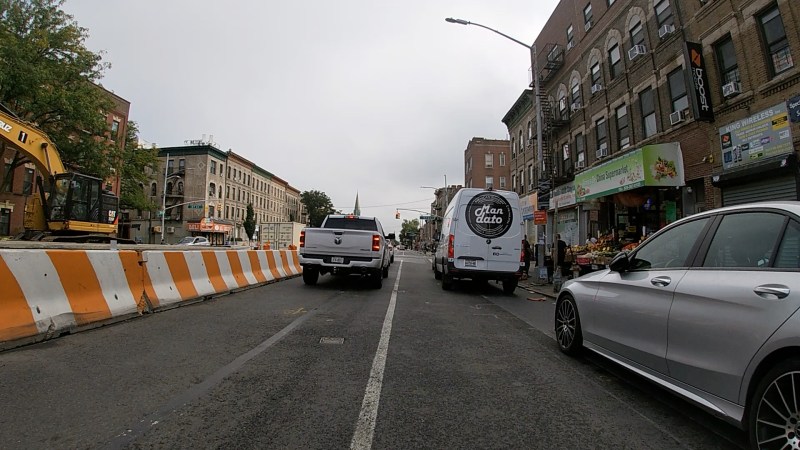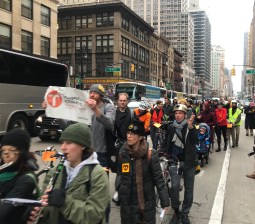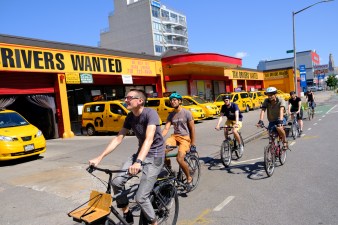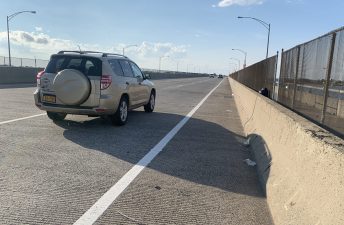SAFETY LAST: DOT Admits To Intentionally Endangering Cyclists on Brooklyn’s Fourth Avenue

The Department of Transportation is forgoing a city law by refusing to create a temporary bike lane to protect cyclists on Fourth Avenue amid construction along the crucial Brooklyn corridor — a pro-car, anti-safety move that one activist called “bullshit.”
The Department of Design and Construction earlier this month began a $60-million “Great Streets” project to install raised, landscaped medians, safer pedestrian refuge areas and benches to the three-mile stretch between Atlantic Avenue and 64th Street. Once done, the existing protected bike lane will also be repainted.
But in the meantime, in order to accommodate the work, the city is throwing cyclists into danger by eliminating portions of the parking-protected bike lane between Eighth and 64th streets, and turning it into a lane for drivers. As construction progresses down Fourth Avenue, the shared lanes will move with it, DOT says.
The DOT finished the Fourth Avenue bike lane between Downtown and Sunset Park in 2020, but has not restored the green paint markings after repaving the roadway last year — and now the agency admits it will not keep the bike lane protections during the Great Streets construction.
In a letter to advocates earlier this month, DOT Commissioner Ydanis Rodriguez that his agency will not follow Local Law 124, requiring a temporary bike lanes if the existing bike lane is obstructed during construction projects — even though Rodriguez, then a local council member, was one of the supporters of the law proposed by Manhattan Council Member Carlina Rivera in 2019.
Rodriguez’s support has evaporated in the case of Fourth Avenue because, he claims, maintaining a that dedicated path for cyclists while work is going on would delay drivers.
“DOT determined that the approximately one-mile vehicle backups expected to occur from converting a traffic lane into a bike lane would introduce a significant number of turning conflicts at high pedestrian-volume intersections by vehicles seeking a detour,” Rodriguez said in an Oct. 3 letter to Bike New York and Bike South Brooklyn, both of which had rung alarm bells about the Great Streets construction. “Traffic would also negatively impact surrounding residential and school blocks that are not designed to accommodate higher vehicle volumes safely. For these reasons we have decided to waive LL 124 in this very specific case.”
— Bike New York (@bikenewyork) October 17, 2022
On Fourth Avenue now, in three block stretches, DOT is removing the bike lane and parking in order to accommodate the construction, leaving two lanes of traffic, one of which is to be shared by cyclists and drivers. Right now, the “dead zone” is between 49th and 52nd streets, according to DOT.
The shared lane is often overtaken by drivers who illegally park in it, dangerously encroaching even more on cyclists’ space, say advocates — one of whom didn’t mince words in response to DOT’s excuse, using a barnyard epithet to describe Rodriguez’s letter.
“The DOT’s justification for choosing to ignore local law 124 while it makes these upgrades is bullshit,” said John Tomac of Bike South Brooklyn.
Tomac added that no such backup exists now, even with cars illegally blocking the shared lane, and suggesting one a mile-long — roughly 20 blocks — is ridiculous.
“The suggestion that removing a traffic lane from a few blocks on Fourth Avenue will cause a mile long back-up is laughable and doesn’t match the reality on the ground,” he said. “What used to be the bike lane and is now supposed to be a ‘shared lane’ isn’t functioning as one. Because it’s next to the curb, drivers are parking there. A handful of parked cars have essentially made Fourth Avenue a one-lane road in each direction through Sunset Park. Despite this, traffic is not backed up into Park Slope or Bay Ridge like they said it would.”
And Brooklyn Borough President Antonio Reynoso, who also voted in favor of the law as a local council member, told Streetsblog that the city leaving cyclists to fend for themselves is exactly why the law was written in the first place.
“This conversation Bike New York and Bike South Brooklyn are having with our Department of Transportation is exactly why I supported Local Law 124 in 2019,” Reynoso said in a statement. “New Yorkers are doing their best to move about our city in a way that is environmentally friendly and safe, and protected bike lanes are essential to that. I’m glad that this bill is empowering residents to begin a dialogue with our DOT about how we balance structural improvements to our city with public safety. … I will always support our communities for advocating for what they need to enjoy our city safely and equitably.”
A one mile vehicle backup would be 20 blocks. That's an unreasonable modeling result and they have to know that.
There are so many ways a DoT that cared about cyclists could approach this instead of throwing their arms up and saying "hope you don't die!!!"
— Ariel Kadouri (@akadouri) October 17, 2022
The law, which took effect in June 2019, does leave some wiggle room for the city to opt out.
“In the event the commissioner determines that maintenance of a temporary bicycle lane is not feasible on such street segment (sic) or intersection (sic), such determination shall not prohibit issuance of the permit,” the law reads.
So the city is not technically in violation of Local Law 124, Orcutt said.
Still, he and Tomac also asked the city to make basic safety improvements along the entire corridor that serves as a crucial connector between Bay Ridge and Downtown Brooklyn, like by upgrading the buffer area with more physical protections since the area as it exists now is too narrow.
But DOT basically ignored them all, Orcutt said, adding that ensuring cyclist safety on Fourth Avenue could have been a major opportunity for the “Get Stuff Done” mayor to prove its willingness to put people before cars. But Hizzoner and team didn’t bite, following in the footsteps of his predecessor, former Mayor Bill de Blasio, who tore up the street for resurfacing and then forgot about it.
“We thought the whole situation was an opportunity for the Adams administration to put safety above traffic flow. They didn’t take that. It was resurfaced in 2021 and never finished,” he said. “Adams’s folks could come in as good guys here. We’re focused on this because this is kind of a flagship bike lane for Brooklyn, the longest protected bike lane in Brooklyn by far.”

Tomac also blasted DOT for justifying its decision in the name of kids, as if they don’t also walk and bike to school, or get killed by reckless drivers on the way there. An investigation by Streetsblog found that streets near schools have higher rates of crashes and injuries than the citywide average, particularly impacting schools with high percentages of poor students or children of color.
“Did it ever occur to them that teachers and students use the bike lane to get to school? Do they not deserve a safe route to school? If the city is genuinely concerned about the threat drivers pose to school children, they could close streets near schools to car traffic,” he said.
The Fourth Avenue bike lane, when it was functioning properly, did save lives, according to city data. In 2018, before it was installed, there were 470 reported crashes in the segments between First and 15th streets and between 17th and 64th streets, injuring 148 people. After the bike lane went in, in 2021, there were 207 reported crashes along the same stretch, injuring 118 people.
Sunset Park Council Member Alexa Aviles penned her own letter to DOT in September after receiving “numerous complaints” from constituents, demanding the agency “install an alternative, fully protected bike lane where the road can accommodate one.” She also called on the 72nd Precinct to address illegal parking along Fourth Avenue in what’s now the shared lane.
Aviles’s office said she did not receive a response. And the NYPD did not respond to a request for comment.
https://twitter.com/BriHedden/status/1562812617462190080
During the second phase of work between Atlantic Avenue and Eighth Street, which is not expected to start until 2025, the city will install concrete pedestrian islands, concrete curb extensions, grade-separated bike lanes (along specific segments), concrete turn-calming treatments at intersections, and bus bulbs and bus islands. The existing protected bike lanes will be maintained during this phase, according to DOT.
A spokesperson for DOT defended its decision, saying the shared lane will allow work to move more quickly in order to create a better and safer redesigned Fourth Avenue sooner.
“The major bike and pedestrian improvements on Fourth Avenue will build on the success of DOT’s bike lanes with a full suite of capital upgrades, including concrete pedestrian island, curb extensions, grade-separated bike lanes, and other enhancements” said Vin Barone. “This work will slow down turning drivers, better protect those walking and cycling along the avenue, and make the entire area safer for all road users, and we appreciate New Yorkers’ patience during these major bike and pedestrian improvements.”



